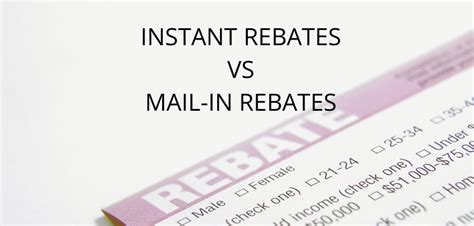Unlocking Savings: What’s the Real Meaning of Mail-In Rebates?
In today’s consumer-driven world, saving money is a top priority for many shoppers. One popular method that retailers use to entice customers is the mail-in rebate. While this promotional strategy can offer significant savings, understanding how it works is essential for maximizing the benefits. This article delves into the concept of mail-in rebates, exploring their mechanics, benefits, and potential pitfalls.
What is a Mail-In Rebate?
A mail-in rebate is a marketing tactic where customers can receive a portion of their purchase price back after submitting a rebate form and proof of purchase to the retailer or manufacturer. Often offered by companies to promote specific products, mail-in rebates encourage consumers to try new items or stimulate greater sales volume during promotional periods.
How Do Mail-In Rebates Work?
The process of obtaining a mail-in rebate typically includes several steps:
- Purchase a Qualifying Product: The first step is to buy a product that comes with a mail-in rebate. This information is generally available in advertisements, on product packaging, or on the retailer’s website.
- Collect Required Documentation: Once you have made the purchase, you need to keep the receipt and, in many cases, the original packaging, as these items are often required for rebate submission.
- Fill Out the Rebate Form: A rebate form, usually available online or at the point of sale, must be completed. This form will ask for details about the product, purchase date, and the store from which you purchased it.
- Submit Your Documentation: Send the completed rebate form, along with the proof of purchase, to the address specified by the retailer or manufacturer. This process may require mailing physical copies, or some companies may allow online submissions.
- Wait for Your Rebate: After submitting the necessary documentation, rebates generally take a few weeks to process. Once approved, a check or prepaid card is sent to the customer.
Benefits of Mail-In Rebates
Mail-in rebates can provide significant financial benefits, including:
- Cost Savings: By using rebates, consumers can effectively reduce the purchase price of products, making pricey items more affordable.
- Incentives for Trying New Products: Many retailers use rebates to promote new products or brands, allowing consumers to try them at a reduced cost.
- Product Loyalty: By offering rebates, companies encourage customer feedback and loyalty for their products.
Potential Pitfalls of Mail-In Rebates
While mail-in rebates offer great potential savings, they also come with certain drawbacks:
- Complexity of the Process: The submission process can be confusing, and missing any required documentation may lead to the rejection of the rebate.
- Delays in Receiving Funds: Customers might wait weeks, or even months, to receive their rebate, leading to frustration.
- Not All Rebates are Honored: Some consumers report difficulties in redeeming their rebates, with companies sometimes denying valid claims based on minor errors in the application.
Maximizing Your Mail-In Rebate Experience
To increase the odds of successfully receiving your rebate, consider the following tips:
- Read the Terms Carefully: Always read the fine print associated with the rebate offer. This includes understanding the eligibility requirements, submission deadlines, and processing times.
- Keep Accurate Records: Maintain copies of everything you send, including receipts and completed rebate forms. This can serve as proof in case of disputes.
- Be Aware of Eligibility Criteria: Some rebates are only applicable to specific models or sizes, so ensure you are buying the correct item.
The Role of Technology in Rebates
With the rise of technology, many companies have started offering digital rebate processing. Mobile apps and online platforms have streamlined the submission process, allowing consumers to take photos of their receipts and submit forms electronically. This shift not only reduces processing times but also helps minimize errors that can occur with traditional mail-in submissions.
Is It Worth the Effort?
Many consumers have successfully benefitted from mail-in rebates, but whether it’s worth the effort often depends on individual preferences and shopping habits. For those willing to navigate the submission process and wait for their funds, the potential savings can be substantial. However, if the process feels too tedious or complicated, shoppers might find it more beneficial to look for discounts or sales that do not require additional steps.
Conclusion
Mail-in rebates represent a unique and often beneficial way to save on purchases. Understanding how they work, their potential drawbacks, and tips for maximizing the experience can help consumers unlock the most savings. By being diligent about documentation and ensuring clarity on eligibility, shoppers can better navigate mail-in rebates and enjoy the financial benefits they promise. With a little patience and effort, mail-in rebates can be an excellent addition to a savvy shopper’s toolkit.
FAQs
What happens if my mail-in rebate is denied?
If your rebate is denied, carefully review the rejection notice to understand the reason. Common issues include missing documentation or submission after the deadline. If you believe your claim was valid, you can often contact customer service for clarification or appeal the decision.
Are there limits to how many rebates I can submit?
Many companies now allow online submissions for rebates, which can simplify the process. Check the rebate form or the company’s website for options regarding digital submissions. The time frame for receiving a mail-in rebate can vary widely, typically taking anywhere from 4 to 8 weeks after submission. Some companies may provide tracking options to monitor the status of your rebate. Not every product will have beneficial rebate offers. It’s essential to evaluate the value of the rebate relative to the item’s price and whether the purchase aligns with your needs.Can I submit a rebate online?
How long does it take to receive my rebate?
Are mail-in rebates worth it for every product?
Download Mail In Rebate Meaning
